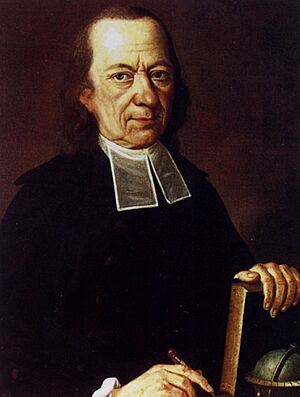Friedrich Christoph Oetinger facts for kids
Friedrich Christoph Oetinger (born May 2, 1702 – died February 10, 1782) was a German Lutheran thinker and religious writer. He explored deep spiritual ideas and tried to connect them with science.
Contents
Early Life and Studies
Friedrich Christoph Oetinger was born in Göppingen, Germany. He was a very curious person from a young age.
From 1722 to 1728, he studied philosophy and Lutheran religious teachings at the University of Tübingen. During his studies, he was very interested in the writings of Jakob Böhme. He also paid attention to the ideas of famous philosophers like Gottfried Leibniz and Christian Wolff.
Travels and New Ideas
After finishing his university studies, Oetinger spent several years traveling. He was always looking for new knowledge and understanding.
In 1730, he visited Count Zinzendorf in Herrnhut. He stayed there for several months. During this time, he taught Hebrew and Greek.
During his travels, Oetinger met many different kinds of people. He talked with spiritual thinkers, independent religious groups, Christians, and learned Jews. He also spoke with religious leaders and physicians. He wanted to learn from everyone.
Belief in Universal Salvation
Some groups, like the Philadelphian Society, influenced Oetinger's beliefs. They taught him about apocatastasis. This is the idea that all people would eventually be saved by God.
Oetinger included this belief in his own religious system. He based his ideas mainly on parts of the First Epistle to the Corinthians and the Epistle to the Ephesians from the Bible.
Becoming a Pastor and Experimenting
After some time, Oetinger became a minister. He served in several churches starting in 1738.
From 1746, he was a pastor in Walddorf, near Tübingen. While there, he studied alchemy. This was an old practice that combined science and magic. He did many experiments.
Oetinger's goal was to use his knowledge of nature for symbolic religious purposes. He once said, "My religion is the parallelism of Nature and Grace." This meant he saw connections between the natural world and God's spiritual gifts.
However, his experiments sometimes led to misunderstandings. Some people attacked him because they did not understand his work.
Swedenborg's Influence and Later Life
Oetinger also translated some of Emanuel Swedenborg's writings. Swedenborg was a Swedish scientist and philosopher who wrote about heaven and earth. Oetinger added his own notes to these translations.
In 1760, Oetinger defended Swedenborg's work. He even invited Swedenborg to Germany. His own book, Swedenborg's and other Earthly and Heavenly Philosophies, was published in 1765.
His translations and support for Swedenborg caused problems with his church leaders. But the Duke of Württemberg protected him. Later, Oetinger was put in charge of churches in the Weinsberg area.
He then held the same position in Herrenberg. Finally, in 1765, he became a prelate (a high-ranking church official) in Murrhardt. He started this role in 1766 and died there in 1782.
See also
 In Spanish: Friedrich Christoph Oetinger para niños
In Spanish: Friedrich Christoph Oetinger para niños


